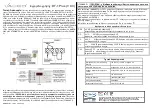
2.7 Reader wiring
Each reader port supports a reader with TTL (D1/D0, Clock/Data), F/2F (standard or supervised) or 2-wire
RS-485 signaling (OSDP reader for example). Power to the readers is selectable: 12 V DC (VIN must be
greater than 20 V DC), or power is passed-through (PASS) from the input voltage of the LP1502 (TB1-VIN),
300 mA maximum per reader port. Readers that require different voltage or have high current requirements
must be powered separately. Refer to the reader manufacture specifications for cabling requirements. In the
2-wire LED mode the buzzer output is used to drive the second LED. Reader port configuration is set via the
host software.
To fully utilize each reader port:
n
TTL signaling requires a 6-conductor cable (18 AWG).
n
F/2F signaling requires a 4-conductor cable.
n
RS-485 signaling requires two 2-conductor cables. Use one cable for power (18 AWG) and one cable for
communication (24 AWG, with drain wire and shield).
Note:
For OSDP cable lengths greater than 200 ft (61 m) or EMF interference, install 120
Ω
+/- 2
Ω
resistor
across RS-485 termination ends.
Note:
Data 0 and Data 1 wires for Wiegand may be reused for OSDP. However, standard Wiegand cable may
not meet RS-485 twisted pair recommendations. The reuse of cable works best on shorter cable
lengths at lower data rates.
J7 – Reader power select
12V PASS
Reader power
12 V DC is available on reader ports (VIN > 20 V DC)
VIN power is "passed through" to reader ports
Caution:
If the input voltage to the LP1502 is 12 V DC, jumper J7
MUST
be in the
PASS
position.
Input power
Reader power select
Reader output
Notes
24 V DC
Pass-through
24 V DC
24 V DC
12 V DC
12 V DC
12 V DC
Pass-through
12 V DC
12 V DC
12 V DC
0 V DC
Caution:
Do not use
PLT-05244, A.3
12
June 2021
Powering
Trusted Identities
HID Mercury™ LP1502 Controller
Installation and Specifications








































